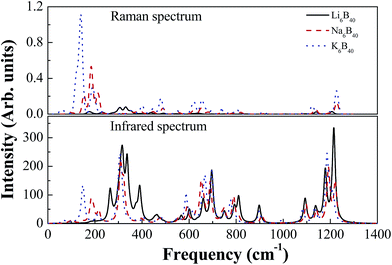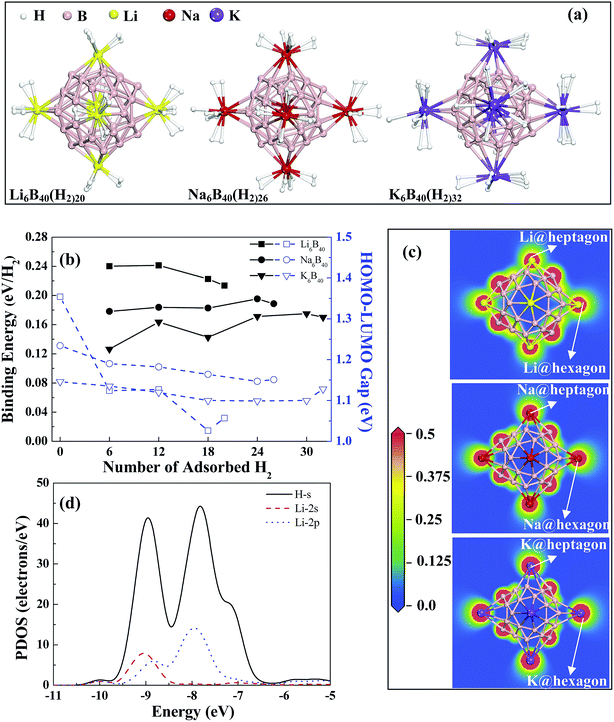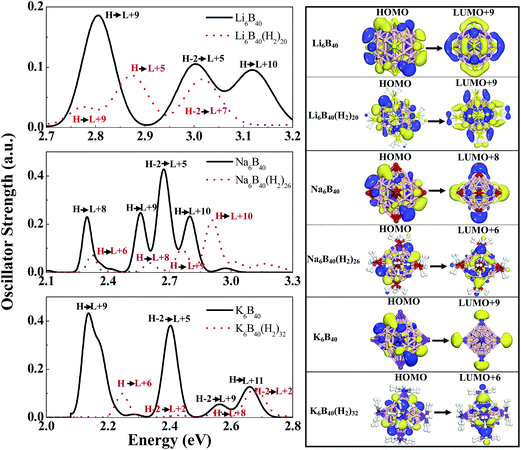Metalized B40 fullerene as a novel material for storage and optical detection of hydrogen: a first-principles study
Chun-Sheng Liu*,
Xiao-Juan Ye*,
Xiangfu Wang and
Xiaohong Yan
Key Laboratory of Radio Frequency and Micro-Nano Electronics of Jiangsu Province, College of Electronic Science and Engineering, Nanjing University of Posts and Telecommunications, Nanjing 210023, People’s Republic of China. E-mail: csliu@njupt.edu.cn; yexj@njupt.edu.cn
First published on 7th June 2016
Abstract
The first experimentally observed all-boron fullerene (B40) has potential applications in hydrogen storage [Nat. Chem., 6, 727 (2014)]. The surface of B40 fullerene contains 4 heptagonal rings and 2 hexagonal rings, which may facilitate metal atom adsorption. Based on (van der Waals corrected) density functional theory, we show that alkali metal (AM) adsorbed on B40 can serve as a promising candidate not only for hydrogen storage, but also for hydrogen detection. The binding energy of AM atoms on B40 strengthens, due to the energetically favorable B 2p-AM p orbital hybridization. Thus, AM atoms are not likely to form clusters on B40, indicating a good reversible hydrogen storage. The (AM)6B40 can reach a gravimetric capacity of ∼8 wt% hydrogen with an optimal adsorption energy that is intermediate between the physisorbed and chemisorbed state. Interestingly, the number of adsorbed H2 molecules per AM atom depends on the position of the AM atoms adsorbed on the B40 surface. Furthermore, the optical absorption spectra of (AM)6B40 before and after hydrogen molecule adsorption are computed and a clear red (blue) shift is observed. These results can serve as a guide in the design of promising hydrogen storage materials and optical sensors based on the B40 fullerene.
1. Introduction
Hydrogen has been considered as a clean alternative energy carrier because of its efficiency, abundance, and environmental friendliness. The (U.S.) Department of Energy target for an ideal hydrogen storage material is that the gravimetric density of hydrogen should reach 5.5 wt% by the year 2020.1 To develop economical hydrogen energy, carbon (C) nanostructures decorated with light metal atoms have widely attracted attention as potential hydrogen storage media due to their light weights and large surface areas.1–6 For instance, it was suggested that AM atoms can produce a uniform coating on C60, taking advantage of the larger binding energy between AM and C60 than the cohesive energy of the bulk AM.7 However, Sun et al. found that the binding energy (0.075 eV per H2) of H2 molecules in the Li–C60 system is too small for room temperature applications.8Therefore, the enhancement of the local electric field produced by these AM positive ions can significantly improve H2 adsorption. On the one hand, substitutional doping of boron (B) at the carbon site in carbon materials may be effective. When some of the C atoms are replaced by B atoms, the system becomes electron-deficient. Consequently, more electrons can be transferred from the AM atoms to the substrate, leaving AM positive ions in a more positively charged state. For example, the hydrogen adsorption energy in Li-decorated B-doped fullerene can reach 0.135 eV per H2, which lies in the desirable energy window.9 On the other hand, some novel boron nanostructures have been presented as good substrates to hold AM atoms strongly, owing to boron being an electron-deficient element. Specifically, boron nanomaterials decorated with AM atoms can reversibly adsorb H2 molecules with an optimal hydrogen adsorption energy.10–12
Very recently, a fascinating all-boron fullerene structure, the B40 hollow cage, was uncovered through a joint experimental/theoretical study.13 The relevant theoretical simulation indicates that B40 fullerene is thermally stable at temperatures as high as 1000 K. These results inspired us to consider whether AM-coated B40 are efficient hydrogen storage media. In addition, a hydrogen leak is dangerous and its detection becomes challenging. Therefore, it is desirable to obtain information on whether the hydrogen storage materials are fully charged or if the adsorbed hydrogen molecules have been released. As is well known, many of these sensors involve electrical conductors, limiting their suitability for use in potentially explosive environments.14,15 In this study, we conduct theoretical studies of high-capacity hydrogen storage media consisting of AM atoms coated on B40, and report an optical detection of hydrogen which is based on measurement of the hydrogen induced changes to the optical properties of the alkali metal-coated borospherene.
2. Computational methods
The first-principles density-functional theory (DFT) calculations were carried out using the linear combination of atomic orbital and spin-unrestricted method implemented in the DMol3 package.16 The generalized gradient approximation [Perdew–Burke–Ernzerhof (PBE)17] together with an all-electron double numerical basis set with a polarization function (the DNP basis set)18 have been chosen for the DFT calculation. The real-space global cutoff radius was set to be 5.10 Å. For geometric optimization, the forces on all atoms were optimized to be less than 0.01 eV−1. We performed van der Waals calculations based on the Tkatchenko and Scheffler (DFT-TS) approaches.19 For all the obtained structures, we performed a normal-mode analysis to check whether the structures optimized without any symmetry constraints were true minima on the potential-energy surface. All binding energies have been corrected for zero point energies at the PBE-TS level. The optical excitation spectra are calculated using the time dependent density functional theory (TDDFT) as implemented in DMol3 (at the B3LYP level) with ALDA kernel exchange–correlation terms.20To check the accuracy and convergence of our DFT calculations, we first calculated the bond length (0.749 Å) and binding energy (4.55 eV) of H2, which are in good agreement with the experimental values of 0.74 Å and 4.53 eV, respectively.21 For the B40 cluster, the average length of the B–B bond (1.67 Å) and the HOMO (the highest occupied molecular orbital)–LUMO (the lowest unoccupied molecular orbital) gap (3.05 eV), agree well with the calculation values of 1.71 Å and 3.13 eV.13
3. Results and discussions
The surface of B40 fullerene contains 48 boron triangles, embedded by 4 heptagonal rings and 2 hexagonal rings. The hexagons are planar while the heptagons are non-planar. First, several possible sites were considered for the adsorption of a single AM atom on B40. After varying the position of the AM atom and relaxing all structures, we find that the optimal positions of AM turn out to be above the centers of the hexagon and heptagon. Then, we placed one AM atom on top of each hexagon and heptagon of B40 to obtain (AM)6B40, as presented in Fig. 1. It is observed that the interaction between the B40 fullerene and the AM atom is quite strong: the average binding energies of the Li and Na atoms are 3.55 and 2.71 eV, respectively. Similarly, the binding energy of K in K6B40 (2.64 eV per K) is lower than in the Li case, whereas the Li–B distance is less than that of K–B. These binding energies are obviously much higher than the cohesive energy of the bulk AM [Fig. 1], suggesting that the coating complexes are rather stable. To further check the stability of the isolated (AM)6B40 clusters, we carried out molecular dynamics simulations at room temperature (T = 300 K) with a time step of 1 fs and massive generalized Gaussian moments thermostat with a Nosé chain length of 2 and a Yoshida parameter of 3.22 After running 5000 steps, we found that the structure retains its identity.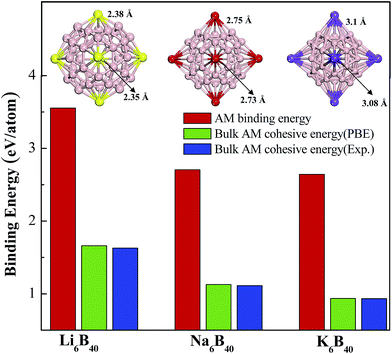 | ||
| Fig. 1 Calculated binding energy per AM atom for (AM)6B40 clusters. For comparison, both theoretical (at the PBE level) and experimental cohesive energies of the bulk AM are given.23 The top inset panels show the optimized configurations of (AM)6B40 clusters. | ||
The stability of (AM)6B40 was further tested by frequency spectra analysis. As shown in Fig. 2, the calculated vibrational frequencies are all real and thus the stability of the (AM)6B40 cluster is substantiated. The (AM)6B40 cluster has significant Raman peaks in the low-frequency range, whereas the IR spectra show a wide distribution of frequencies ranging from 100 to 1200 cm−1. In comparison with the vibrational spectra of Li6B40, the Na6B40 (K6B40) spectra indicate redshifts in the low-frequency range. For instance, the lowest Raman (IR) active modes are at 170 (264.2), 88.5 (183.5), and 55.9 (147.5) cm−1 for Li6B40, Na6B40 and K6B40, respectively. Furthermore, the spectra reveal intensity peaks at two characteristic frequencies. The first part (170–600 cm−1) can be associated with the AM–B bond stretching and the AM atom vibration around the B40 cluster surface. The second part (600–1300 cm−1) is related to the B–B bond stretching. Specifically, in the Raman spectra, the intensity of the K–B bond stretching mode is 12(2) times larger than that of the Li(Na)–B bond stretching mode, suggesting weak bonding between K and B40. The predicted trend in the IR/Raman spectra of (AM)6B40 clusters will be helpful in future experiments.
To understand the nature of the bonding of the AM on the B40 cluster, an analysis of the electronic properties is essential. Interestingly, according to the population analysis of both the Hirshfeld and Mulliken methods, the charge transfer from AM to B40 decreases in the order of K, Na, and Li, which is not compatible with the order of their binding energies. This means that the bonding between AM atoms and B40 is not simply ionic, distinctly different from the ionic bonding in Li-, Na-, and K-decorated C60 [ref. 7]. As shown in Fig. 3, the stronger Li 2p–B 2p orbital hybridization compared with the Na 3p(K 4p)–B 2p orbital hybridization indicates a stronger interaction between Li and B40. The average binding energy per Li atom on B40 in the Li6B40 complex has a higher value but with a relatively smaller net charge transfer. This bonding mechanism can also be observed in the case of Li binding onto boron fullerenes and boron-doped graphenes.10,24 In addition, the calculated binding energies of the AM on the B40 borospherene are larger than that of AMC60 (1.80 eV per atom for Li, 1.37 eV per atom for Na, and 1.99 eV per atom for K).7 Clearly, the B40 borospherene is a suitable substrate for AM coating.
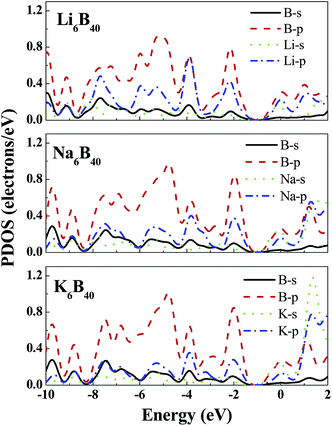 | ||
| Fig. 3 The partial density of states (PDOS) in the (AM)6B40 complex. The PDOS for the spin-up and spin-down components are identical. The Fermi level is at zero energy. | ||
We now investigate the interaction between these complexes and hydrogen molecules. The first H2 is adsorbed in molecular form, and prefers to tilt toward the AM atoms so that one of the two H atoms of the adsorbed H2 molecule becomes relatively closer to the AM atom. We continue to introduce successive hydrogen molecules near the AM atom. It is energetically favorable for Li6B40, Na6B40, and K6B40 to adsorb 20, 26, and 32 H2 molecules, respectively, corresponding to 7.8, 8.4, and 8.8 wt% gravimetric densities. A summary of the geometries related with the adsorption of H2 by (AM)6B40 is depicted in Fig. 4(a). Interestingly, the number of adsorbed H2 molecules per AM atom depends on the position of AM atoms adsorbed on the B40 surface. In detail, the metal atom located above the center of the hexagonal ring can attach to one more hydrogen molecule than that binding to the heptagon. We define the average hydrogen adsorption energy with the following term: En = [E(AM6B40) + nE[H2] − E(AM6B40nH2)]/n. We find that Li coating results in strong molecular hydrogen binding sites [Fig. 4(b)]. On the other hand, Na and K atoms bind H2 much more weakly. This trend is consistent with the results obtained for the AM-coated C60 fullerene case.7 Such optimal molecular hydrogen binding energies make hydrogen adsorption and desorption at ambient conditions possible, which is critical for practical applications. Especially, the average H2 adsorption energy does not undergo significant changes as the number of H2 molecules increases. In contrast, for C60 and B40 coated with transition metals, the H2 binding strength sensitively varies with the number of attached H2 molecules.25,26 In order to test the kinetic stability of the above hydrogen coated systems, we have plotted in Fig. 4(b) the HOMO–LUMO gaps as a function of the number of adsorbed hydrogen molecules. We note that the energy gap slightly decreases when increasing the number of H2 molecules. The HOMO–LUMO energy gaps are larger than 1 eV, which is comparable to that of the B80 fullerene (1 eV),27 suggesting kinetic stability for hydrogen coated systems.
Next, we address the underlying adsorption mechanism. In the case of the AM-coated B40 fullerene, the adsorption of hydrogen molecules is essentially driven by the electrostatic interaction between the induced dipole and the quadrupolar interaction of the molecules with the field generated by the cations formed due to the charge transfer to the B40 cluster. In detail, there is a larger transfer of charge from the AM@hexagon to the B40 cluster. To give a more detailed account of the effects induced by the charge distribution, we show in Fig. 4(c) a two-dimensional contour plot of the all-electron electrostatic potential energy calculated for (AM)6B40. The different potential energies between the AM@hexagon and AM@heptagon show that the enhanced electric field around the AM@hexagon causes more H2 molecules to be adsorbed. Besides the polarization effect discussed above, the orbital interactions are also responsible for the binding of H2 to Li6B40. From the PDOS analysis [Fig. 4(d)], the peak of the Li 2p orbitals hybridizes with the H s orbitals, resulting in electron transfer between the H2 σ orbitals and Li 2p orbitals. The consequences of the orbital interactions are as well reflected in the charge variations of the Li. As shown in Fig. 5, the effective charge of the Li atom varies as the number of adsorbed hydrogen molecules per metal atom increases from 1 to 3 (and 4). On the contrary, as the number of adsorbed H2 molecules increases, the charge on Na and K are almost unchanged.
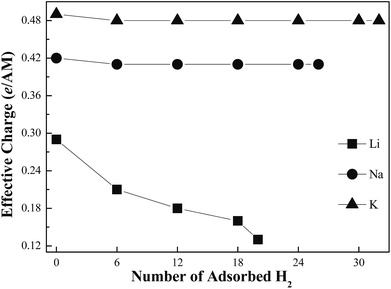 | ||
| Fig. 5 The average effective charge on the AM atoms with respect to the number of H2 molecules adsorbed. | ||
An ideal storage system would not only be kinetically stable but would also involve molecular desorption of hydrogen at ambient conditions. We now estimate the desorption temperature, TD, using the van’t Hoff equation:28
 | (1) |
Fig. 6 shows the variation of the optical absorption spectra for the (AM)6B40 and (AM)6B40(H2)nmax complexes from TDDFT calculations. The main optical absorption occurs in the energy range of about 2.0–3.3 eV which falls in the ultraviolet-visible region. It seems to contradict the obtained HOMO–LUMO gaps of about 1–1.4 eV [Fig. 4(b)]. The reason for this difference is in the application of the TDDFT method, which significantly increases the HOMO–LUMO gap of the systems toward their fundamental gap.
It is quite clear that the hydrogen adsorption induces a red shift (blue shift) in the optical absorption of the (Li)6B40 (Na6B40 and K6B40) cluster. In order to clarify these issues, we analyzed the origin of the first absorption peak and excited state compositions. As illustrated in Fig. 6, the first peak in the (AM)6B40 complexes is mainly caused by the optical transitions between B p states and AM s states, corresponding to a charge transfer from B to AM. Furthermore, the analysis of the molecular-orbital coefficients for the Li6B40 complex shows that the LUMO+9 comes from the hybridized 2p2s orbitals of Li and the 2p orbitals of B, indicating that B40 back-donates some electrons to the low lying Li 2p orbitals. However, the LUMO+8 (LUMO+9) for Na6B40 (K6B40) has predominantly s-orbital character and is mainly located on the Na (K) atoms. On the other hand, for (AM)6B40(H2)nmax, the HOMO appears as a mixture, including ∼60% p from the orbitals of the B atoms and the rest from AM s orbitals. The components of the LUMO+9 in (Li)6B40(H2)20 are similar to those of the LUMO+6 in Na6B40(H2)26 and K6B40(H2)32. However, the contribution of the s orbitals of H atoms in (Li)6B40(H2)20 is twice that in Na6B40(H2)26 and K6B40(H2)32. These results suggest that alkali metal-coated borospherenes can be potential optical sensors for the hydrogen molecule.
4. Conclusions
In conclusion, the functionalization of B40 with AM atoms for reversible hydrogen storage was studied using density-functional theory. Six AM atoms are strongly attached to the centers of 4 heptagons and 2 hexagons of the B40 fullerene. Homogeneously coating B40 with AM atoms are thermodynamically stable against metal clustering. The hydrogen storage capacities of Li6B40, Na6B40, and K6B40 are 7.8, 8.4, and 8.8 wt%, respectively, and exceed the target of the U.S. Department of Energy (5.5 wt% by the year 2020). The average adsorption energy of H2 on AM coated B40 is suitable for room-temperature storage, while above room temperature hydrogen molecules are released and AM atoms remain adsorbed on the substrate for further recycling. The computed absorption spectra show that hydrogen molecule adsorption induces a red (blue) shift in the absorption spectra of (Li)6B40 (Na6B40 and K6B40), indicating their potential as optical sensors for the hydrogen molecule.Acknowledgements
This work was supported by the Natural Science Foundation of the Jiangsu Higher Education Institutions of China (No. 14KJB140011 and 15KJA510001), the Natural Science Foundation of Jiangsu Province (No. BK20141421 and BK20150826), and the Scientific Research Foundation of Nanjing University of Posts and Telecommunications (No. NY213073).References
- http://energy.gov/sites/prod/files/2014/11/f19/fcto_myrdd_storage.pdf.
- P. Jena, J. Phys. Chem. Lett., 2011, 2, 206 CrossRef CAS; Q. Wang and P. Jena, J. Phys. Chem. Lett., 2012, 3, 1084 CrossRef PubMed.
- X. Chen, F. Yuan, Q. Gu and X. Yu, J. Mater. Chem. A, 2013, 1, 11705 CAS.
- Y. F. Zhao, Y. H. Kim, A. C. Dillon, M. J. Heben and S. B. Zhang, Phys. Rev. Lett., 2005, 94, 155504 CrossRef PubMed.
- M. Yoon, S. Yang, C. Hicke, E. G. Wang, D. Geohegan and Z. Y. Zhang, Phys. Rev. Lett., 2008, 100, 206806 CrossRef PubMed.
- C. S. Liu and Z. Zeng, Phys. Rev. B: Condens. Matter Mater. Phys., 2009, 79, 245419 CrossRef.
- K. R. S. Chandrakumar and S. K. Ghosh, Nano Lett., 2008, 8, 13 CrossRef CAS PubMed.
- Q. Sun, P. Jena, Q. Wang and M. Marquez, J. Am. Chem. Soc., 2006, 128, 9741 CrossRef CAS PubMed.
- Q. Sun, Q. Wang and P. Jena, Appl. Phys. Lett., 2009, 94, 013111 CrossRef.
- Y. C. Li, G. Zhou, J. Li, B. L. Gu and W. H. Duan, J. Phys. Chem. C, 2008, 112, 19268–19271 CAS.
- S. Er, G. A. de Wijs and G. Brocks, J. Phys. Chem. C, 2009, 113, 18962 CAS.
- H. An, C. S. Liu and Z. Zeng, Phys. Rev. B: Condens. Matter Mater. Phys., 2011, 83, 115456 CrossRef.
- H. J. Zhai, Y. F. Zhao, W. L. Li, Q. Chen, H. Bai, H. S. Hu, Z. A. Piazza, W. J. Tian, H. G. Lu, Y. B. Wu, Y. W. Mu, G. F. Wei, Z. P. Liu, J. Li, S. D. Li and L. S. Wang, Nat. Chem., 2014, 6, 727 CAS.
- C. Christofides and A. Mandelis, J. Appl. Phys., 1990, 68, R1 CrossRef CAS.
- A. Chtanov and M. Gal, Sens. Actuators, B, 2001, 79, 196 CrossRef CAS.
- B. Delley, J. Chem. Phys., 1990, 92, 508 CrossRef CAS.
- J. P. Perdew, K. Burke and M. Ernzerhof, Phys. Rev. Lett., 1996, 77, 3865 CrossRef CAS PubMed.
- B. Delley, J. Chem. Phys., 2000, 113, 7756 CrossRef CAS.
- A. Tkatchenko and M. Scheffler, Phys. Rev. Lett., 2009, 102, 073005 CrossRef PubMed.
- B. Delley, J. Phys.: Condens. Matter, 2000, 22, 384208 CrossRef PubMed.
- Handbook of Chemistry and Physics, ed. D. R. Lide, CRC, New York, 75th edn, 1994 Search PubMed.
- B. Delley, Comput. Mater. Sci., 2000, 17, 122 CrossRef CAS.
- C. Kittel, Introduction to Solid State Physics, Wiley, New York, 8th edn, 2005 Search PubMed.
- H. An, C. S. Liu, Z. Zeng, C. Fan and X. Ju, Appl. Phys. Lett., 2011, 98, 173101 CrossRef.
- H. L. Dong, T. J. Hou, S. T. Lee and Y. Y. Li, Sci. Rep., 2015, 5, 09952 CrossRef CAS PubMed.
- Q. Sun, Q. Wang, P. Jena and Y. Kawazoe, J. Am. Chem. Soc., 2005, 127, 14582 CrossRef CAS PubMed.
- N. G. Szwacki, A. Sadrzadeh and B. I. Yakobson, Phys. Rev. Lett., 2007, 98, 166804 CrossRef PubMed.
- W. Zhou, T. Yildirim, E. Durgun and S. Ciraci, Phys. Rev. B: Condens. Matter Mater. Phys., 2007, 76, 085434 CrossRef.
| This journal is © The Royal Society of Chemistry 2016 |

